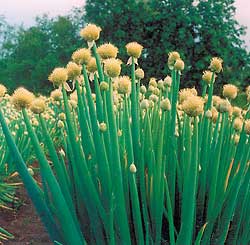The “lilies of the kitchen”–yes, I borrowed the title from a book by Barbara Batcheller (See Bibliography–Vegetable Cookbooks)” are onions, leeks, garlic, shallots, and scallions! They are often hidden away in the sofrito/soffrito or the mirepoix, but they can make fantastic dishes on their own. I can’t imagine a kitchen without these “lilies”. In my kitchen, being without onions and garlic is just about as big a catastrophe as being out of chocolate or coffee!
Can you really cook without all the Allium family? Caramelized onions, roasted garlic, scallions or green onions to add to salads and chives to top the baked potato. Then there are leeks…another under-used, and perhaps, under-appreciated vegetable as an ingredient as a vegetable on their own.
While most of this family are now readily available in the supermarket, there are some that it’s worthwhile growing in your own garden. Others, unless you have a huge garden and want to be self-sufficient, it’s much easier to buy. The regular “yellow” or storage onions that we cook with–they’re inexpensive. Most of us don’t have space or the humidity/temperatures required to store the quantity that we use in a season so buying those makes good sense.
Others like leeks, shallots, and garlic I use in such quantities that I don’t have space or time to tend. Since they are also readily available from the supermarket or the farmer’s market I’ll opt to buy as well. Some that we use “green”–like scallions might be worth growing but still demand space and time.
When we speak of “fresh” onions, we often use the terms green onion, scallion, and spring onion interchangeably but there really are some differences. The green onion and scallion differences are mostly marketing semantics. Spring onions are just regular onions (that would eventually form a bulb) harvested while immature–as when you have to thin the onion you planted too close together. Scallions, on the other hand, are species of allium that do not form a fully developed bulb. If you’re a huge fan of alliums of all sorts there are some perennial perennials that can be good substitutes for those fresh ones that we normally buy, and they can be grown in small spaces–or even large containers.

A. fistulosum
Allium fistulosum, or bunching onion is a possible stand-in for those green onions from the grocery store if you want to grow your own. While the “Welsh” is a misnomer since these came from China originally, the taste is still “green onion”, sometimes grown as an ornamental. You can find bunching onions from Johnny’s Selected Seeds.
The Egyptian (this may also be a misnomer) –my favorite–is just plain fun with its unusual appearance that will definitely be a topic of conversation.

A. cepa x proliferu
Other common names include tree onion, top onion, walking onion, Canada onion, and Catawissa onion which may all refer to various cultivars. The Egyptian Walking Onion, Egyption Onions , Biodiverseed and Mother Earth News websites provide some glimpses into the rather mysterious history of these (and other) onions.
Genetically it has been shown to be a cross between the common allium (Allium cepa) and the “Welsh” onion (above). Botanically speaking, it is Allium cepa x proliferum. These form bulbs, but also have top-sets which can be shared with friends. These plants multiply from the bulb in the ground as well as by producing top-sets, and sometimes topsets on topsets, rather than seeds. These onions are most often found from growers or seed catalogs specializing in heirloom vegetables such as Territorial Seeds, although a Google search shows them available from eBay and Amazon.
Potato onions (multiplier onions, shallots) or Allium cepa var. aggregatum are also perennial alliums. These do not produce topsets, but rather “multiply” from bulbs left in the ground over the winter.
Multiplier (Allium porrum), perennial, multiplying or “Musselburgh” leeks (Allium ampeloprasum), though smaller than annuals, can provide the taste of leeks without the amount of effort involved with annual leeks. These are also called garden leeks.
More information on sites like Edible Gardening, Hope Seeds, Southern Exposure Seed Exchange, FoodForestFarm.com , inhabitat.com, and icultivate.net. Grow some “lilies of the kitchen” and don’t ignore others like chives. Then there’s garlic: for a method of growing without yearly planting check out The One Straw Revolution.
—Ô¿Ô—
_
